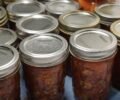Homemade Ketchup: A Delicious and Natural Recipe

1
Welcome to Outdoors and Country Living! I'm Leanne, and today we're diving into the world of homemade ketchup. This recipe is not only free from dyes, flavorings, and thickeners but also packed with the natural goodness of fresh tomatoes. Whether you're using it for side dishes, meat, fish, pizza, or dumplings, this homemade ketchup is sure to become a kitchen staple.
Harvesting and Preparing the Tomatoes
This year, we've had an abundant tomato harvest, so making homemade ketchup is a great way to preserve these beauties. Here's a step-by-step guide to making your own delicious ketchup:

2
Selecting the Tomatoes: Choose ripe, juicy tomatoes. For this recipe, I picked a bucketful of tomatoes, weighing about 5 kilograms after peeling.
Peeling the Tomatoes: Wash the tomatoes thoroughly, remove the skins, and weigh them to ensure you have a clean 5 kilograms.
Chopping the Ingredients: Cut the tomatoes into large chunks. There's no need to finely chop them as they will break down during cooking. Additionally, chop 500 grams of onions and 500 grams of paprika into cubes.
Adding Garlic: Include 3 cloves of garlic for that extra flavor.
Cooking the Ketchup
Combine the Ingredients: Place the tomatoes, onions, and peppers into a large pot. Add one tablespoon of salt. The salt helps the tomatoes cook faster by drawing out the moisture.
Simmer: Bring the mixture to a boil, then let it simmer for about an hour. This allows the ingredients to blend and the flavors to meld together.
Blending: After an hour, use a blender to puree the mixture until smooth.

3
Seasoning: Add 250 grams of sugar, one tablespoon of salt (remember you already added salt earlier), one teaspoon of cinnamon, 4 cloves, and one teaspoon of mixed pepper (white and black). Blend well to mix all the spices evenly.
Adding Vinegar: Pour in 50 milliliters of 9% vinegar. This adds a tangy flavor and helps in preservation. Mix thoroughly.

4
Thickening: Let the ketchup simmer for another 15-20 minutes to thicken.
Bottling the Ketchup
Sterilize Jars: Ensure your jars are clean and sterilized before pouring in the ketchup.
Filling the Jars: Use a funnel to fill the jars with hot ketchup, leaving a little headspace at the top.

5
Sealing: Seal the jars with lids and process them in a water bath canner for 10 minutes to ensure they are properly preserved.

6
Cooling: Let the jars cool down. Once cooled, store them in a cool, dark place. Your homemade ketchup is now ready to enjoy!
Tips and Tricks
Taste and Adjust: Always taste your ketchup during the cooking process. You can adjust the seasoning to suit your taste.
Alternative Flavors: Experiment with different spices or herbs to create your unique ketchup flavor.
Storing: Properly canned ketchup can last up to a year in a cool, dark place. Once opened, store in the refrigerator and use within a month.
Homemade ketchup is not only delicious but also healthier than store-bought varieties. Enjoy it with your favorite dishes, and you'll never go back to the store-bought version. Happy cooking!

7
This recipe is perfect for anyone looking to make natural, flavorful ketchup at home. With fresh ingredients and simple steps, you can enjoy a condiment that's not only delicious but also free from artificial additives. Happy preserving!

Ingredients
Directions
1
Welcome to Outdoors and Country Living! I'm Leanne, and today we're diving into the world of homemade ketchup. This recipe is not only free from dyes, flavorings, and thickeners but also packed with the natural goodness of fresh tomatoes. Whether you're using it for side dishes, meat, fish, pizza, or dumplings, this homemade ketchup is sure to become a kitchen staple.
Harvesting and Preparing the Tomatoes
This year, we've had an abundant tomato harvest, so making homemade ketchup is a great way to preserve these beauties. Here's a step-by-step guide to making your own delicious ketchup:

2
Selecting the Tomatoes: Choose ripe, juicy tomatoes. For this recipe, I picked a bucketful of tomatoes, weighing about 5 kilograms after peeling.
Peeling the Tomatoes: Wash the tomatoes thoroughly, remove the skins, and weigh them to ensure you have a clean 5 kilograms.
Chopping the Ingredients: Cut the tomatoes into large chunks. There's no need to finely chop them as they will break down during cooking. Additionally, chop 500 grams of onions and 500 grams of paprika into cubes.
Adding Garlic: Include 3 cloves of garlic for that extra flavor.
Cooking the Ketchup
Combine the Ingredients: Place the tomatoes, onions, and peppers into a large pot. Add one tablespoon of salt. The salt helps the tomatoes cook faster by drawing out the moisture.
Simmer: Bring the mixture to a boil, then let it simmer for about an hour. This allows the ingredients to blend and the flavors to meld together.
Blending: After an hour, use a blender to puree the mixture until smooth.

3
Seasoning: Add 250 grams of sugar, one tablespoon of salt (remember you already added salt earlier), one teaspoon of cinnamon, 4 cloves, and one teaspoon of mixed pepper (white and black). Blend well to mix all the spices evenly.
Adding Vinegar: Pour in 50 milliliters of 9% vinegar. This adds a tangy flavor and helps in preservation. Mix thoroughly.

4
Thickening: Let the ketchup simmer for another 15-20 minutes to thicken.
Bottling the Ketchup
Sterilize Jars: Ensure your jars are clean and sterilized before pouring in the ketchup.
Filling the Jars: Use a funnel to fill the jars with hot ketchup, leaving a little headspace at the top.

5
Sealing: Seal the jars with lids and process them in a water bath canner for 10 minutes to ensure they are properly preserved.

6
Cooling: Let the jars cool down. Once cooled, store them in a cool, dark place. Your homemade ketchup is now ready to enjoy!
Tips and Tricks
Taste and Adjust: Always taste your ketchup during the cooking process. You can adjust the seasoning to suit your taste.
Alternative Flavors: Experiment with different spices or herbs to create your unique ketchup flavor.
Storing: Properly canned ketchup can last up to a year in a cool, dark place. Once opened, store in the refrigerator and use within a month.
Homemade ketchup is not only delicious but also healthier than store-bought varieties. Enjoy it with your favorite dishes, and you'll never go back to the store-bought version. Happy cooking!

7
This recipe is perfect for anyone looking to make natural, flavorful ketchup at home. With fresh ingredients and simple steps, you can enjoy a condiment that's not only delicious but also free from artificial additives. Happy preserving!

Leave a Review
Please log in or register for a new account in order to leave a review.










